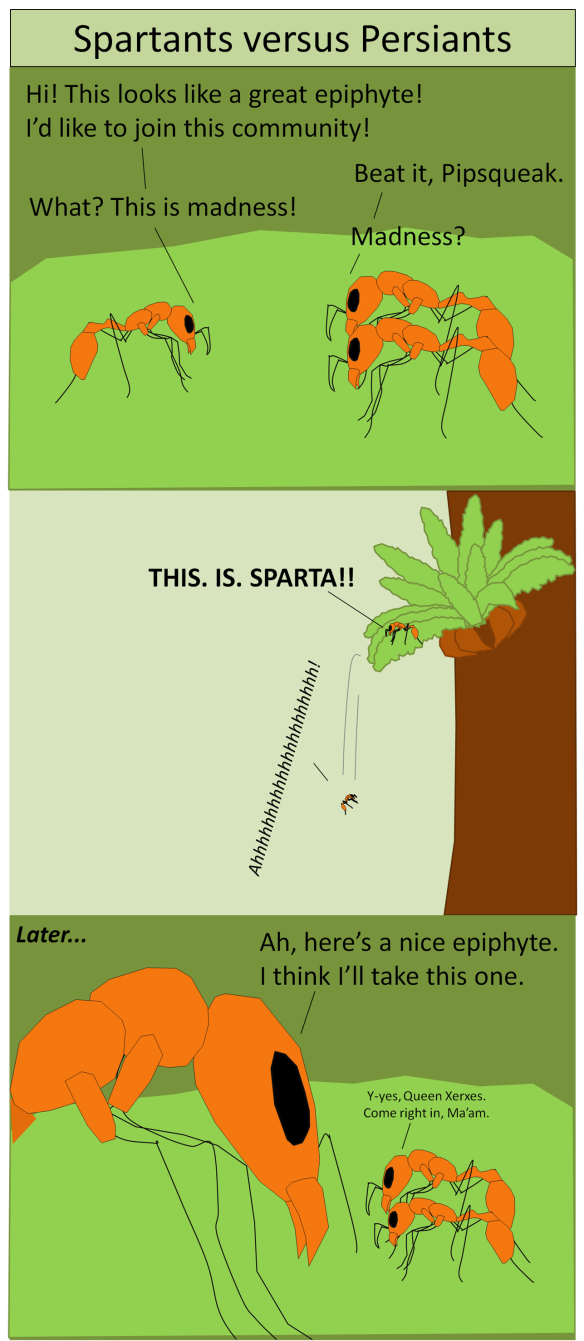On Monday night, I read an amazing paper. It was so amazing that I knew I’d need to save it for my post on Parasite Ecology’s second birthday…which I then realized was less than two days away. So, in the past 24 hours, I have fallen hopelessly in love with ants (again!), reorganized two months worth of queued posts, and made a symbiont cartoon incorporating the phrase, “This is Sparta!” – something that I’ve been waiting for the right moment to do for TWO YEARS. The moment has arrived. Happy Birthday, Parasite Ecology!
As we’ve talked about previously, some ants live on plants in special hollow chambers that the plants provide called domatia. But ants can also live on plants that don’t provide domatia, such as the epiphytic birds’ nest ferns that trap leaf litter in the canopies of tropical forests. Amazingly, up to 12 ant species can be found living together on just one of these epiphytes! But what determines exactly which species can be found living together?
Ant competition might be a major structuring force that determines which ant species live together in a given epiphyte community, and ant species that are most similar in size may be more likely to compete. And in fact, in a survey of 86 epiphytes, ant species that were similar in size were less likely to co-occur than one would predict based on a null model (Fayle et al. 2015). But that doesn’t prove that competition is driving the observed pattern, so Fayle et al. (2015) conducted an experiment where they inoculated epiphytes with single or multi-host communities of ants, and then two days later, they inoculated the same epiphytes with an “invader” species. There was strong competition between similarly sized ants, but not between ants of disparate sizes. Furthermore, the threshold size ratio between the invading and resident ants that determined whether there was strong competition or not was roughly the same in both the observational study and the invasion experiments. And get this:
“In each replicate, an invading colony was introduced into a fern, which was supported on a fluon-coated cylinder above a fluon- coated container, and left for 24 h with ants ejected from the fern falling into the container. Competition manifested as direct attacks between workers of different colonies, with ants sometimes being thrown from the edge of the fern (Appendix S3).”
Ok, but we’re not done! Fayle et al. (2015) took things a step further and ran simulations with different sets of species assembly rules to see which set of rules, if any, could re-create the community diversity patterns that they observed in the field. Their null model was that size-based competition didn’t matter, so that every species had the same probability of invading a community, regardless of the sizes of the resident species. They compared this to four other sets of rules (1a, 1b, 2a, 2b), where the relationship between the invader-resident size difference and the strength of competition was described as a (1) threshold assembly rule or a (2) saturating assembly rule and competition between ants was assumed to be (a) between the invader and the resident of the most similar size (nearest neighbor competition) or (b) between the invader and all resident species (diffuse competition). The rules that resulted in the best fit to the observed diversity patterns were the combination of the saturating relationship between the invader-resident size difference and the strength of competition and nearest neighbor competition (2a). SO. COOL.
Go check out the paper! It’s open access.
Reference:
Fayle, TM, P Eggleton, A Manica, KM Yusah, and WA Foster. 2015. Experimentally testing and assessing the predictive power of species assembly rules for tropical canopy ants. Ecology Letters 18: 254–262.


Pingback: The parasite ecology papers that got away: Part I | Parasite Ecology